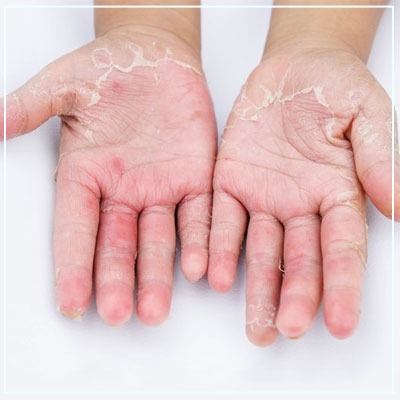Contact Dermatitis Treatment in Mumbai
Contact Dermatitis
Contact dermatitis occurs when the skin becomes irritated or inflamed as a result of coming into contact with an allergenic factor. It exhibits some of the same symptoms as eczema.

Types of Contact Dermatitis
Irritant Contact: Irritant contact dermatitis, which accounts for 80% of all contact dermatitis, does not include an immune system reaction. Instead, it occurs when skin cells are injured as a result of exposure to irritants such as solvents, detergents, soaps, bleach, or nickel-containing jewellery. Makeup, hair colour, nickel-containing scissors, belt buckles, or clothing with metal snaps or zippers can also cause responses, as can excessive hand-washing with hot water and soap and wearing scratchy wool.
Allergic Contact Dermatitis: Allergic contact dermatitis is a delayed allergic reaction that manifests as a rash a day or two after exposure with an allergen. Poison ivy is a common example. Following exposure, the body produces a strong inflammatory response to the plant’s oils, resulting in an itchy rash within one to two days. Fragrances, nickel, and thimerosal, a preservative present in some topical antibiotics, are all prominent causes of allergic contact dermatitis.
Treatment

Topical Steroids: Anti-inflammatory drugs are used in the form of topical steroids. They help to get the rash under control faster and are often used 1-2 times each day. Topical steroids are available in a variety of formulations and concentrations . If the rash does not improve after 7 days or worsens, you may require some other treatment .
Antihistamines: 5Oral antihistamines that are sedating improve sleep but may cause dryness, trouble peeing, dizziness, and poor coordination. Sedating antihistamines should be taken with caution in older individuals for the reasons stated above, as well as a possible link with dementia. These drugs should be used in conjunction with a visit to your doctor.
Antibiotics: If there are open fissures and symptoms of a subsequent bacterial infection, several lotions or ointments may be administered.
Systemic Steroids: These drugs, which can be taken orally or by injection, may be required if the rash is severe, associated with swelling, or covers a large portion of your body. When recommended for brief periods of time, they will result in quick improvement and are usually regarded as safe.
Phototherapy: If the rash does not react to the preceding treatments, your doctor may recommend you for light therapy.
Phototherapy is the controlled application of ultraviolet (UV) light to treat skin disorders such as atopic dermatitis. During therapy, ultraviolet B (UVB), ultraviolet A (UVA), or a combination of the two may be employed. Adults with mild, moderate, or severe atopic dermatitis may benefit from phototherapy.
Immunomodulators for the Skin: Topical calcineurin inhibitors (pimecrolimus, tacrolimus) are anti-inflammatory medications that may be an option for patients with ACD or ICD. They do not induce skin thinning, which is advantageous in the treatment of patients suffering from facial dermatitis and dermatitis in other sensitive areas (bending areas, genitals). The most common side effects include burning and itching at the application site.
For more information & consultation on Contact Dermatitis Treatment in Mumbai , visit VIVA Aesthetic Clinic at Opera House or contact us on 022 3573 1556 | 93245 89084 or simply fill in your name and number & one of our team member will get in touch with you soon. Our team of experts along with Dr. Deepam Shah, MD. DNB. FAM – Dermatologist, Cosmetologist & Hair Transplant Surgeon, will help you out in understanding your problem and guide you through every stage of your treatment.
At Viva Aesthetic Clinic, we offer Hair transplant, Aesthetic treatments and skin care with the help of latest technology, world class procedures and a dedicated team led by Dr.Deepam Shah . We are your one-stop clinic in India for comprehensive Hair Restoration, cosmetic laser treatment and skincare solutions.
